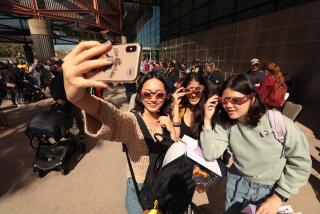Safety Workers Take Dim View of the Dark
- Share via
DAYTON, Ohio — A missing child and escaped killers from a prison breakout are believed to be hiding after dark in the same backwoods area. Swarms of rescuers and police officers converge and search with night-vision goggles.
What’s wrong with this picture?
Unlike the American military, many police, park rangers and rescue squads that would like to have night-vision goggles can’t afford them.
“Super expensive,” said Montgomery County Sheriff Gary Haines.
The sheriff’s office gets by with a couple of older night-vision binoculars for the SWAT team and night surveillance.
“They’re unbelievable. They’re definitely a help,” said Maj. Ron Casey. But the department doesn’t have the money for more night-vision equipment that it wants, he said, especially the latest high-quality goggles.
Teams formed by the Ohio Department of Rehabilitation and Correction to respond to prison disturbances have trained with night-vision goggles, but the agency doesn’t own any.
“It’s kind of on their wish list,” said department spokesman Joe Andrews.
Members of the Miami Valley Urban Search and Rescue Task Force also have trained with borrowed night-vision goggles.
“They’re impressive,” said spokesman Scott Hall. The military probably would lend the rescue squad goggles in an emergency, he said, but the squad cannot afford to buy them.
“It’s very expensive technology,” Hall said. “There are a whole lot of other trinkets that can be bought before that.”
Specialized Technical Services of suburban Beavercreek sells its latest goggles to the military for $12,000 to $14,000 apiece. Company chairman Robert Lupini says he expects the cost to drop by as much as 30% with increased sales and production.
“Even on a starlit night when it’s really black out there for our own eyes, there’s always a little light,” said Lupini. “This device amplifies that light about 50,000 times.”
The battery-powered goggles also detect heat, enabling users to better spot enemy troops or someone lost in the woods at night. And the goggles have infrared technology so they can be used where there is no light, such as in caves.
Designed for aggressive movements, the goggles are smaller than conventional equipment and can be attached to helmets. The optics, encased in hard plastic, are made to withstand pressures at 50 feet under the sea and altitudes of 50,000 feet.
Rep. David L. Hobson (R-Ohio), who sits on the House Appropriations military construction subcommittee, is impressed with the equipment. He said the goggles would be invaluable to paratroopers and pilots who must make night landings.
“This type of thing saves lives and helps people accomplish their mission successfully,” he said. “Going into any kind of conflict, a war fighter will tell you he always wants to be one up on his opponent. This helps him be one up in adverse conditions.”
Lt. Col. Joseph Celeski, a student at the U.S. Army War College in Carlisle, Pa., has used night-vision goggles for many years, first as a tank operator and later as a member of special forces.
“The purpose of all of this is to see at night. It’s that simple,” he said. “It gives you a tactical overmatch at the point it’s being used.”
Although the United States may once have held the edge when it comes to seeing at night, potential adversaries now have their own night-vision goggles. But Celeski said he believes the goggles used by U.S. forces offer sharper vision and better depth perception.
Researchers at Wright-Patterson Air Force Base are testing “panoramic” night-vision goggles that more than double the field of vision available from conventional goggles.
Lee Task, of the Air Force Research Lab, said older night-vision goggles have their drawbacks.
“Try driving your car by looking through a couple of toilet-paper tubes,” said Task.
He said the new goggles enable users to see more without having to move their head. However, the panorama goggles are not expected to be fully operational for several years.
Lupini said night-vision goggles could help SWAT teams, fire departments, park rangers, crews that repair downed power lines at night and even night fishermen.
Lupini said he once lent a pair to a Kentucky game warden.
“He chased down a poacher,” Lupini said. “The guy ran out into the woods, and he just followed him with the goggles.”
More to Read
Sign up for Essential California
The most important California stories and recommendations in your inbox every morning.
You may occasionally receive promotional content from the Los Angeles Times.













